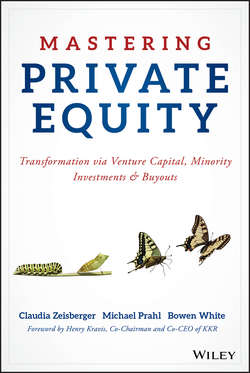Читать книгу Mastering Private Equity - Prahl Michael - Страница 7
На сайте Литреса книга снята с продажи.
SECTION I
PRIVATE EQUITY OVERVIEW
ОглавлениеThe first section of the book provides readers with a high-level introduction to the institutional private equity (PE) market – from early-stage venture capital to growth equity and buyouts, plus a brief description of several alternative PE strategies. While buyouts have historically accounted for the vast majority of global PE capital deployed,2 venture capital and growth equity investment activity has steadily increased as the industry matured over the past decades (see Exhibit A).
Exhibit A: Total PE Industry Capital Deployed by Strategy
Source: Preqin
Section I is by far the least technical part of this book, intended to familiarize newcomers with the asset class and the concept of investing institutional capital in private companies in return for equity stakes. While crucial for readers new to PE, professionals familiar with the industry may choose to move directly to later sections of the book.
SECTION OVERVIEW
CHAPTER 1. PRIVATE EQUITY ESSENTIALS: This chapter defines the traditional limited partnership fund model, specifically the players involved, a fund’s investment lifecycle, and typical fund economics and fee structures. To be clear, our work refers to the organized PE market, i.e., professionally-managed equity investments by specialized intermediaries (PE firms) and their institutional backers; it excludes other forms of “informal” private capital investments.
CHAPTER 2. VENTURE CAPITAL: Venture capital (VC) generally flows into early-stage companies – start-ups – that offer high risk/high return investment opportunities. We introduce the different types of venture investors (business angels, start-up incubators and accelerators, VC funds, and corporate VCs) and explain the use of VC at different points in a company’s development, from proof-of-concept to commercialization and scaling up. Both aspiring entrepreneurs as well as future venture investors will find this chapter useful.
CHAPTER 3. GROWTH EQUITY: Acquiring minority equity stakes in fast-growing companies is the focus of growth equity funds. Managing multiple stakeholders without a control position is a key challenge for these funds; establishing a productive working relationship with existing managers and owners is therefore a key determinant of success. This chapter is particularly relevant for readers interested in PE in emerging markets.
CHAPTER 4. BUYOUTS: Buyout funds acquire controlling equity stakes in mature and sometimes listed target companies, often employing ample amounts of debt in leveraged buyouts (LBOs). The skillset required to execute large LBOs and drive value post-investment differs from that needed for growth equity or VC: it requires both financial and process management skills, combined with the ability to create operational value in the portfolio firms.
CHAPTER 5. ALTERNATIVE STRATEGIES: In the final chapter of this section, we explore alternative PE strategies focused on investing in distressed businesses and real assets. The former requires unique skills to restructure and improve a company’s operations (turnaround) or its balance sheet (distressed debt), while the latter describes a range of strategies (investing in real estate, infrastructure, and natural resources) that use a PE operating model and adapt it to distinct industry verticals.
2
Buyouts have accounted for more than three-quarters of industry capital deployed between 1980 and 2015. Source: Preqin.
